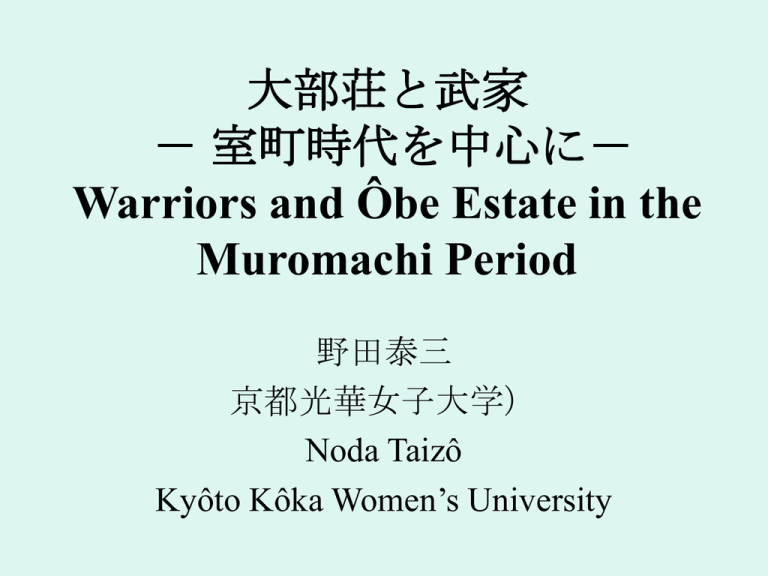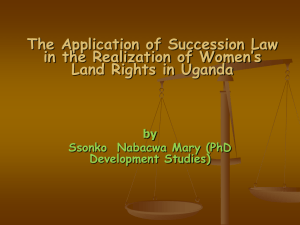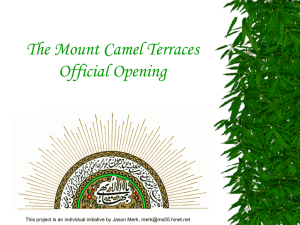ppt format
advertisement

大部荘と武家 - 室町時代を中心に- Warriors and Ôbe Estate in the Muromachi Period 野田泰三 京都光華女子大学) Noda Taizô Kyôto Kôka Women’s University I.南北朝・室町期の守護の 分国支配と荘園 Estates and the Control of Provinces by Military Governors in the Nanbokuchô (1336-1392) and Muromachi (1392-1573) Periods I.1 守護支配の浸透 The Establishment of Shugo Control 内乱期を通じ、播磨はしばしば前戦場に Harima: frequent battlefield during civil war period 守護による戦争遂行体制の構築* Construction of a System of Military Mobilization by the Military Governor (Shugo) (1) • 国内荘園公領への様々 な課役・夫役の賦課 – 城山城拵人夫・材木引 人夫、鎌倉殿弘山御在 所塀塗夫、兵粮米 • Levies of material & labor on estates w/in the province – Construction workers, porters, provisions for soldiers, etc. – Ex.: workers on Shôgun Ashikaga Yoshiakira’s Harima stronghold *cf. 伊藤俊一“一国総動員体制” Itô Shun’ichi, “The Province-Wide Mobilization System” 守護による戦争遂行体制の構築* Construction of a System of Military Mobilization by the Military Governor (Shugo) (2) • 寺社本所領の代官・沙 汰人に対する軍事動員 (「寺社本所代官着到 」) – 暦応年間(1338-42)、預 所・公文代官らが西摂山 系の南朝軍攻略に参陣 • 荘官側には守護の軍勢 催促に応じることによ って所領所職を確保す る意図 • 賦課の恒常化により、 「守護役」として定着 • Officials of temple & shrine holdings mobilized troops – 1338-42: Ôbe custodian & reeve joined shugo’s army in attack on southern court – Thus guaranteeing their holdings & positions • Levies regularized: permanent shugo yaku • 守護は国衙機能、一国規 模祭祀なども掌握し、国 内秩序の担い手に – 節季夫(若菜夫、八朔夫 )など荘園公事の系譜を 引く賦課 • 荘園経営を保障するのは 形式上は幕府、実質的に は守護 – 荘家から守護方(おもに 郡代レベル)に対して日 常的に恒例・臨時の礼物 や夫役、物資(炭・茶・ 材木など)の提供・贈与、 見返りに荘園経営が保障 される • Military governors assert control over existing system – E.g., they appropriate seasonal laborers once levied by proprietor • Bakufu formally guarantees security of estates; but de facto guarantor is the shugo – Shugo exacted various levies in return for protection of estate officials’ rights I.2. 播磨における寺社本所領 Temple and Shrine Holdings in Harima 大部荘の浄土寺の浄土堂 Jôdodô, Jôdoji, Ôbe estate 土一揆 (1428-9) Peasant Uprisings 丹波国土一揆以外蜂起之 間、守護(細川持元) 明日可遣人、仍寺社権 門領等之領内ニ専此一 揆在之、厳密ニ可致沙 汰処、自方々被歎申時 、被閣者不可有正体也 、此由可得上意、次如 播磨国諸権門領等可致 其沙汰旨、可被下御教 書旨、同申入了、条々 不可有相違旨御返事在 之、(『満済准后日記 』正長2年2月5) • Temple & shrine holdings became hotbeds of peasant unrest • Bakufu, following the example of the Akamatsu in Harima, decided to crush the uprisings 播磨の徳政一揆 (1428, 冬) Debt relief uprisings in Harima, winter 1428 • 東寺領矢野荘、法隆寺 領鵤荘、宍粟郡伊和社 領など • 守護方の対応 – 「就土一揆之事、矢野庄 守護方ヨリ押置之由注進 」 – 「地下押使入」 – 「庄家押使入」 – 「土一揆兵粮米」 (『廿一口方評定引付』) • Uprisings on Tôji’s Yano estate, Hôryûji’s Ikaruga estate, and the holding of Iwa shrine in Shiso-gun • Shugo takes action – Sends agents to estates – Violently represses uprisings & re-establishes control – Levies provisions for soldiers to support military action 土一揆の拠点としての寺社本所領 To what extent were temple & shrine holdings the bases for uprisings? • 寺社本所領は武家の介 入を忌避する傾向、相 対的に緩やかな支配 • 大部荘代官職請文:「 守護方権門之者等」と 契約しない文言 • Temple & shrine holdings: relatively peaceful because they avoided warrior interference • Document from Ôbe officials states that they did not make a contract with the shugo II. 嘉吉の乱後の守護職の交代 と在地社会への影響 Transfer of the shugo office after the Kakitsu rebellion and its influence on provincial society 守護職の交替 Transfer of the shugo position • 嘉吉元年(1441)9月 赤松氏滅亡 →播磨守護職は三郡を除き山 名持豊へ 1441/9: Akamatsu are defeated; Yamana Mochitoyo becomes shugo of all but 3 Harima districts (Akashi, Miki, Katô); • 文安元年(1444)正月 三郡(明石・三木・加東)が赤松満政か ら山名氏へ;10月 赤松満政・同則尚ら播磨下向・挙兵(→翌年鎮 圧) 1444/1: Yamana assume control of the 3 remaining districts 1444/10: Akamatsu Mitsumasa, Norinao raise troops in Harima; they were defeated the next year. • 享徳3年(1454)11月 赤松則尚、播磨下向(→翌年5月備前で 自害) 1454/11: Norinao enters Harima (commits suicide in Bingo, 1455/5) 在地勢力の交代: 赤松方被官の没落・牢籠、山名方の隆盛 Changes in Local Power: Fall of the Akamatsu, Rise of the Yamana • 『建内記』嘉吉元年 10月28日条): 西守護代宇野満貴は 「近所之道場」に居 住、「彼舎弟十一歳 属守護山名手、仮彼 勢威可支地下(高家 荘)之由」 • 大部荘に入部する垂 井中務丞 • Kennaiki 1441/10/28: “Uno Mitsutaka, deputy shugo in the west, lives in a nearby dôjô. His 11year-old brother serves the shugo (Yamana). He shall unjustly assume control of Takie estate.” • Tarui Nakatsukasa no jô enters Ôbe estate II.2 新守護山名氏の支配 Control by the new shugo, the Yamana • 「奪取寺社本所・武 家人々所領年貢等、 猛悪無度云々、 • 彼若補守護者、一国 可滅亡歟云々」 • 「表濫吹之輩」 • Yamana have “plundered rents that belonged to temple and shrine proprietors and the military;” their actions were “limitless savagery.” • “The whole province will perish if they are appointed shugo!” • They are “gangs of alien thugs.” • 三郡寺社本所領に対する「 郡散号」、代官・給人の配 置 – 寺社本所領の田数・年貢員数 ・長夫立帰夫の実情、本所直 務の実否、赤松・満政期での 本所直務・守護請の変更、闕 所地の調査 • 強圧的な支配と荘園押領 • 寺社本所は幕府御教書 – 幕府-守護体制”に依拠 – 「存礼儀之輩如管領・畠山云 々」 • 細川京兆家を中心に幕閣を 構成し寺社本所保護を方針 とする一派とそれに対抗的 な派閥の形成(応仁大乱の 萌芽) • Yamana replace officials of temple & shrine holdings in Akashi, Miki, & Katô • Oppressive control & invasions of estates • Proprietors appeal to the bakufu – Dependence on bakufu-shugo system – “There are people of virtue, like the Hatakeyama deputy shoguns.” • Conflicting policies w/in bakufu re shrine & temple holdings (seeds of Ônin war) II.2 享徳3年(1454)冬、大 部荘百姓五郎左衛門の殺害 Winter of 1454: the prominent Ôbe estate cultivator Gorôzaemon is murdered 五郎左衛門の殺害 (1454) Gorôzaemon’s assassination • 「彼五郎左衛門者、数年此方為 披官、子息五郎又別而扶持人候 」 • 「図師職源左衛門尉所持分内、 数年掠持之由」 • 「百姓五郎左衛門と申候者、常 陸方(則尚)へ連々内通心さし お存候間、地下人等於以後其煩 と申候て、去年十月丗日夜おし よせ、さた仕候処に、常陸方十 一月ニ乱入候間、五郎左衛門か 子おひたち方より地下ニすへら れ候処候、今度ちくてん仕候、 」 • 「就播州大部庄五郎さ衛門之跡 事、自御屋形被付給主候」 • Gorôzaemon: Yamana retainer who secretly plotted with Akamatsu • Local people feared this would bring chaos to the estate, & therefore killed Gorôzaemon • Local residents’ relationships with shugo influenced estates & caused unrest 守護と荘園 Military governors & estates • 守護方との被官関係→荘園 現地に様々な影響と混乱 • 相論や政治的混乱を契機と した武家方の介入 – 公文職:王氏一族間での相 論 → 豊福氏の掠給、足利義 満による東大寺への寄進 – 図師職:山名氏の介入、応 仁元年には赤松被官(上月 源次郎・三島右京亮) – 矢野荘でも赤松則尚没落時 に例名に給主設置を企図 • Shugo-retainer relationships influenced estates & led to conflict • Warriors used disputes as a chance to intervene, e.g. – Quarrel over the reeve’s position w/in the Ô family →Toyofuku invaded – Yamana seized Gorôzaemon’s record-keeper position but lost it to Akamatsu retainer – Yano estate: plots to put one person after another in charge after Akamatsu Norinao died 既成事実化により寺社本所領 内部に武家領の形成 Thus warrior fiefs formed within estates. . . →戦国期大名権力の基盤 And became the basis for the power of the Sengoku daimyô.








